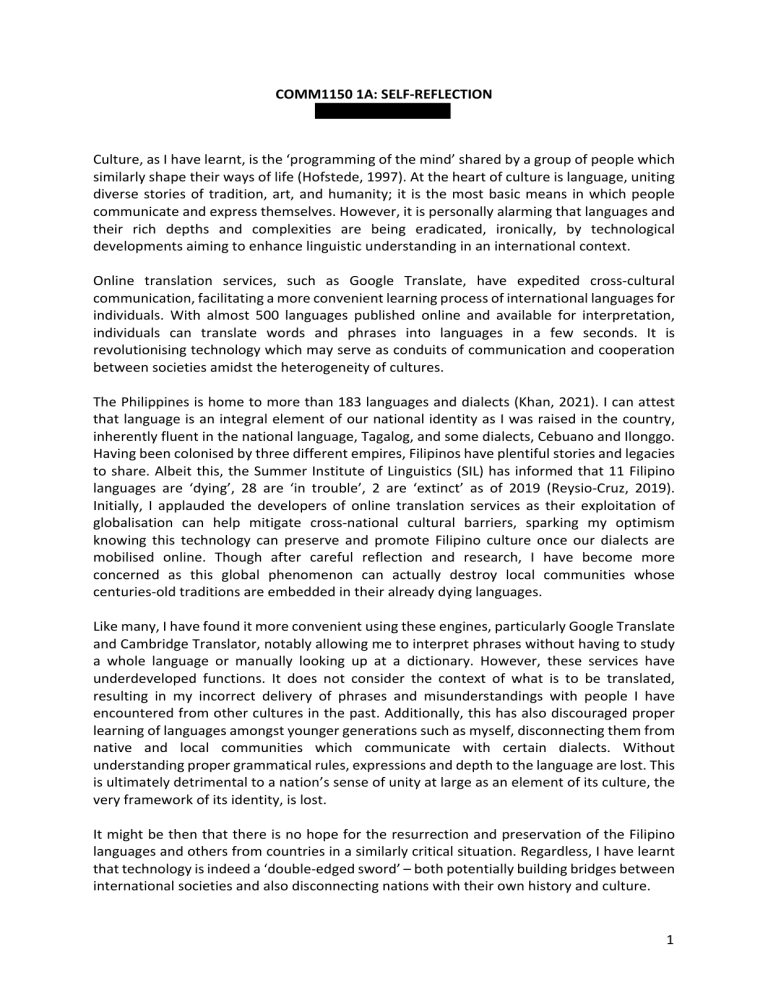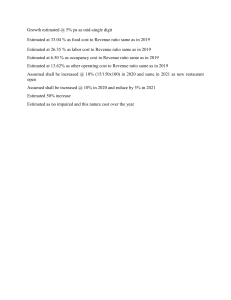
COMM1150 1A: SELF-REFLECTION Culture, as I have learnt, is the ‘programming of the mind’ shared by a group of people which similarly shape their ways of life (Hofstede, 1997). At the heart of culture is language, uniting diverse stories of tradition, art, and humanity; it is the most basic means in which people communicate and express themselves. However, it is personally alarming that languages and their rich depths and complexities are being eradicated, ironically, by technological developments aiming to enhance linguistic understanding in an international context. Online translation services, such as Google Translate, have expedited cross-cultural communication, facilitating a more convenient learning process of international languages for individuals. With almost 500 languages published online and available for interpretation, individuals can translate words and phrases into languages in a few seconds. It is revolutionising technology which may serve as conduits of communication and cooperation between societies amidst the heterogeneity of cultures. The Philippines is home to more than 183 languages and dialects (Khan, 2021). I can attest that language is an integral element of our national identity as I was raised in the country, inherently fluent in the national language, Tagalog, and some dialects, Cebuano and Ilonggo. Having been colonised by three different empires, Filipinos have plentiful stories and legacies to share. Albeit this, the Summer Institute of Linguistics (SIL) has informed that 11 Filipino languages are ‘dying’, 28 are ‘in trouble’, 2 are ‘extinct’ as of 2019 (Reysio-Cruz, 2019). Initially, I applauded the developers of online translation services as their exploitation of globalisation can help mitigate cross-national cultural barriers, sparking my optimism knowing this technology can preserve and promote Filipino culture once our dialects are mobilised online. Though after careful reflection and research, I have become more concerned as this global phenomenon can actually destroy local communities whose centuries-old traditions are embedded in their already dying languages. Like many, I have found it more convenient using these engines, particularly Google Translate and Cambridge Translator, notably allowing me to interpret phrases without having to study a whole language or manually looking up at a dictionary. However, these services have underdeveloped functions. It does not consider the context of what is to be translated, resulting in my incorrect delivery of phrases and misunderstandings with people I have encountered from other cultures in the past. Additionally, this has also discouraged proper learning of languages amongst younger generations such as myself, disconnecting them from native and local communities which communicate with certain dialects. Without understanding proper grammatical rules, expressions and depth to the language are lost. This is ultimately detrimental to a nation’s sense of unity at large as an element of its culture, the very framework of its identity, is lost. It might be then that there is no hope for the resurrection and preservation of the Filipino languages and others from countries in a similarly critical situation. Regardless, I have learnt that technology is indeed a ‘double-edged sword’ – both potentially building bridges between international societies and also disconnecting nations with their own history and culture. 1 REFERENCES Hofstede, G., 1997. Cultures and organizations : software of the mind [Rev. ed.]., McGrawHill, New York. Khan, S., 2021. How Many Languages Are Spoken in Philippines?. [online] Mars Translation. Available at: https://www.marstranslation.com/blog/how-many-languages-are-spoken-inphilippines. Reysio-Cruz, M., 2019. Saving PH diverse languages from extinction. INQUIRER.net. Available at: https://newsinfo.inquirer.net/1155014/saving-ph-diverse-languages-from-extinction. 2



